Here’s a true piece of submachine gun history: a German MP.18–1 submachine gun, a very early, first-generation, Bergmann-built Hugo Schmeisser design.
Schmeisser was the son of designer Louis Schmeisser, who also worked at Bergmann and created the early Bergmann auto pistols. Hugo is one of the true greats of 20th Century weapons design in his own right, but, oddly enough, he is credited more in the popular mind for a gun he didn’t design, the MP 40, than the many guns he did, including the revolutionary MP.18. We’ll explain below how that probably came to pass.
Discounting the curious and tactically unsound Villar–Perosa, the first real submachine gun was the MP.18. (Maxim produced a model only in the late 19th Centuryl he didn’t follow up). It was blowback-operated and fired in full-automatic only (at a rather low rate of fire, thanks to heavy reciprocating parts). The weakness of the MP18, apart from its weight and cost of manufacture, was its magazine feed: it used the 32 round snail drum of the Artillery Luger. (A snail “drum” is not a true drum, exactly, but a box magazine oriented in a spiral to save space. It’s very tricky to design). The snail drum was awkward, hard to load, heavy, and made the MP18 unwieldy, but the gun still proved its worth in the hands of German Storm Troops in the last year of the Great War.
After the war, Schmeisser patented an original design for a 20-round double-column single-feed magazine and a suitable magazine housing (the patent was not filed in the USA until 1931, possibly due to the terms of the Treaty of Versailles). This gun is one of the 20-round versions.
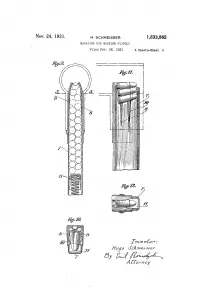 According to Small Arms of the World by Smith and Ezell, these guns were not new production, but were modified by Haenel, and (several other sources suggest that Bergmann lost its production facilities at war’s end, and continued only as a design shop). Some online sources assert that during the war, Schmeisser’s double-column mag had been rejected by the Army in favor of the snail drum, officially the “Trommelmagazin 08″ or TM08, that was already in production for the Artillery pistol. We haven’t seen a definitive source that says that Schmeisser’s stick mag was ready for prime time in 1918.
According to Small Arms of the World by Smith and Ezell, these guns were not new production, but were modified by Haenel, and (several other sources suggest that Bergmann lost its production facilities at war’s end, and continued only as a design shop). Some online sources assert that during the war, Schmeisser’s double-column mag had been rejected by the Army in favor of the snail drum, officially the “Trommelmagazin 08″ or TM08, that was already in production for the Artillery pistol. We haven’t seen a definitive source that says that Schmeisser’s stick mag was ready for prime time in 1918.
This gun on offer is one of those postwar MP.18-1s with the 20-round box mag. Its condition is amazing for a nearly-century-old weapon an ocean away from its home:
This is a excellent German MP18.1 that I have had for a long time. It is in beautiful original condition as you can see by the pictures. It is all matching except for the bolt. The bore is excellent and shiny. It has all the original finish and is NOT re-blued. The magazine housing is marked S.B.848 and the stock is marked “1920” so I’m sure that it was used in the Weimar as a Police Weapon.
The “1920” marking was applied to all Reichswehr (the Weimar Republic’s 100,000-man rump army) weapons when a postwar law banned automatic weapons for the general public. (This early German gun control law was to lead to greater things, but let’s not digress).
It is on a form 3 and is fully transferable on a form 4, though it can NOT be transferred on a C&R. If you have any question or need more pictures please ask.
via German MP18 1 9mm MP18-1 : Machine Guns at GunBroker.com.
The MP.18 was redesigned by Hugo Schmeisser into a slightly improved version, the MP.28, which had a selector switch. It continued in production, spawning many variants. The Schmeisser designs went on to be extremely influential, as well as to serve in many other wars, including the Spanish Civil War, the Sino-Japanese Wars leading up to World War II (including in Chinese-copy versions), and of course in World War II, where it was often found in the hands of the SS. It also inspired the British Lanchester, a fairly direct copy of the MP.28 which actually could use MP 18 and 28 box magazines, although the Lanchester also had 32 and 50 round magazines of its own. This makes the MP 18 not only the progenitor of all submachineguns, but also the granddaddy of the Sten. The Japanese Type 100 was also a modified copy of the MP.28, a weapon the Japanese had encountered in Chinese hands. The Finnish Suomi and Russian PPD also were inspired to one extent or another by the German design, and the.
Schmeisser’s box magazine design was patented, as shown above, and was widely used in subsequent guns. It’s generally accepted that the misnomer “Schmeisser” for the MP40 came about because many MP38 and MP40 magazines were marked with “Schmeisser D.R.P.” (Deutsches Reich Patent) in recognition of this patent.
The gun is extremely durable. The receiver is machined from a thick tube, unlike the thin tubes common in Second World War submachine guns. The bolt likewise is machined from a single block of steel. The weapon fires from an open bolt, automatic only, although experience makes single shots possible. The original WWI versions had no manual safety. This one has a bolt notch safety. (All open-bolt SMGs are only safe with a mag out, period, unless the safety locks the bolt forward on an empty chamber. A safety like this just instills false confidence).
Mullin notes that, other things being equal, a full-stocked SMG always provides a better firing platform than a folding or sliding stock. We concur. Sliding stocks have had something of a renaissance due to body armor, but for the recreational shooter an early subgun like an MP.18 (or a Thompson for that matter) is a joy to shoot.
While the operating system of the gun was very simple, the internals were not. The bolt was driven by a telescoping spring guide/firing pin mechanism clearly antecedent to that of the later Vollmer designs that would culminate in the MP40. What killed the MP.18 and its successors in the end was the difficulty and expense of machining its solid steel parts. Second-generation submachine guns would have stamped, die-cast, and other parts taking advantage of improvements in 20th Century automotive mass-production industrial processes.
We’ve used more of the pictures than we usually do in these auction reports, because this is such a gorgeous, unmolested original gun. If we hadn’t just taken a huge income hit (thank you, ISIL), we’d be on this like a lawyer on an ambulance.
Because the MP.18 isn’t as sexy as later guns, it’s unlikely to be bid up anywhere near Thompson, BAR or M16 territory, and might even sell down in the Sten price range. But this gun is a true piece of history. Its next owner will have something to be proud of, and it may turn out to be a good investment. (Personally, we don’t “invest” in anything subject to corrosion, although we’ve been known to delude ourselves that we did that).
After this, you might want more information on this rare and historic firearm. There’s a minimal write-up in most editions of Small Arms of the World. In the 11th Edition it begins on p. 338. (The book, not the unrelated Small Arms of the World website. There’s probably a good writeup on the website, too, but we’ve been locked out by login problems over the last few weeks… we hope to get them resolved today. SAW’s technical staff have been very helpful). There’s a better writeup, but scarcely a thorough one, in Hobart, on pp. 116-117.
How does the MP.18 stack up today? Mullin’s verdict in The Fighting Submachine Gun: A Hands-on Evaluation was:
The M1918 feels like a good, sturdy, long-lasting weapon. It does have a few drawbacks to it (such as weight and slam-firing bolt-design defects), but once modified to a standard box design, it has all the features necessary to make an effective SMG with very few that are superfluous to the job. This is quite a compliment to those original German designers back in 1918.
Peterson (p. 151) suggests that the gun may be worth $17,000 to $22,500, depending on whether you call its condition “very good” or “excellent”; a snail-drum wartime gun would be worth only 10% more. No one has bid on this gun, at $13,500 opening bid and no reserve. What’s up with that?
Sources:
Hobart, FWA, Pictorial History of the Sub-machine Gun
Mullin, T. The Fighting Submachine Gun: A Hands-on Evaluation.
Peterson, P. Standard Catalog of Military Firearms: The Collector’s Price and Reference Guide.
Smith, WHB and Ezell, EC, Small Arms of the World, any edition.
A very good photo thread on the MP.18 and successors at Accurate Reloading: http://forums.accuratereloading.com/eve/forums/a/tpc/f/7811043/m/589109167/
Note that there are a couple of errors and unsupported statements in the photo thread.

Kevin was a former Special Forces weapons man (MOS 18B, before the 18 series, 11B with Skill Qualification Indicator of S). His focus was on weapons: their history, effects and employment. He started WeaponsMan.com in 2011 and operated it until he passed away in 2017. His work is being preserved here at the request of his family.

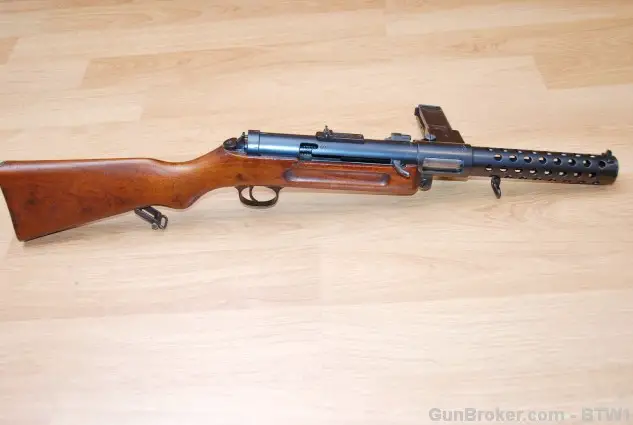
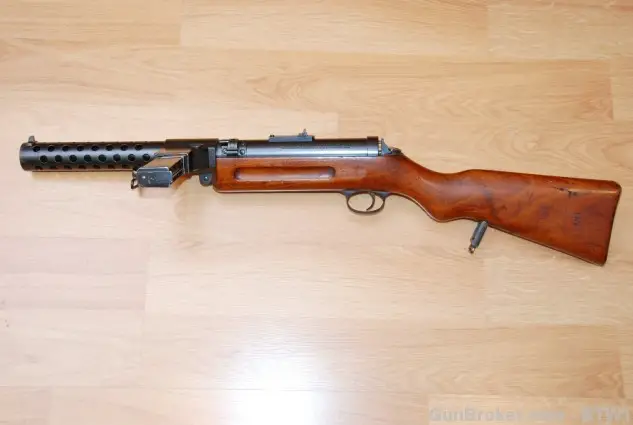
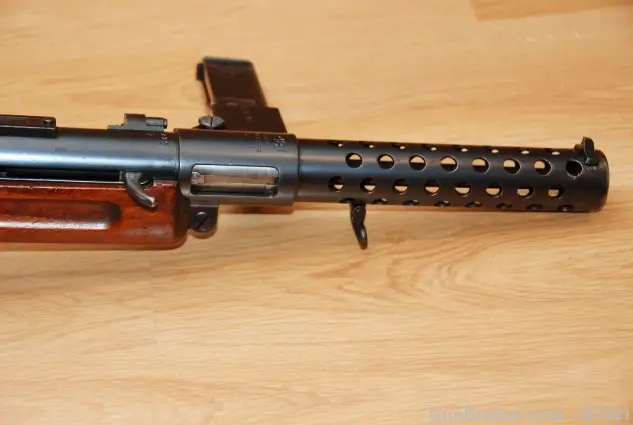
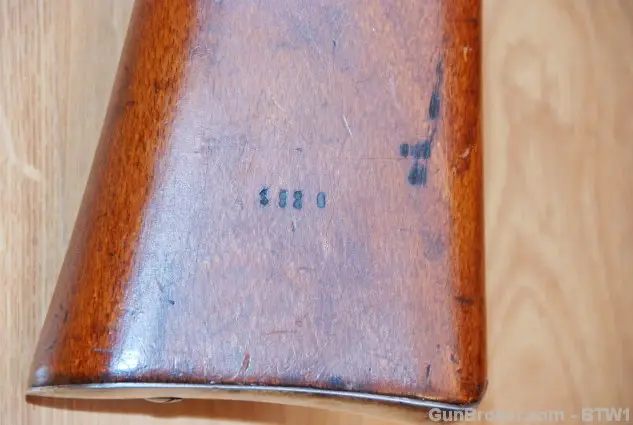
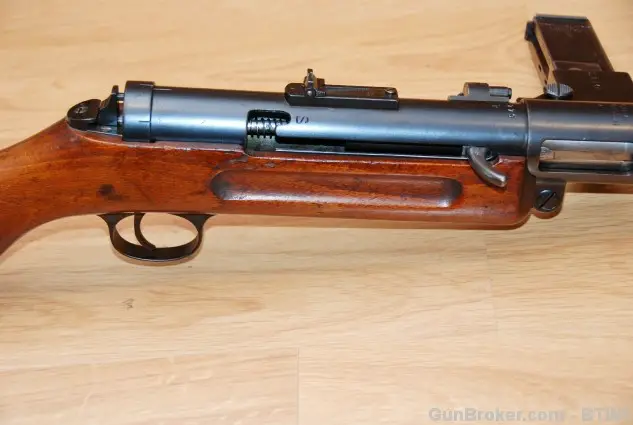
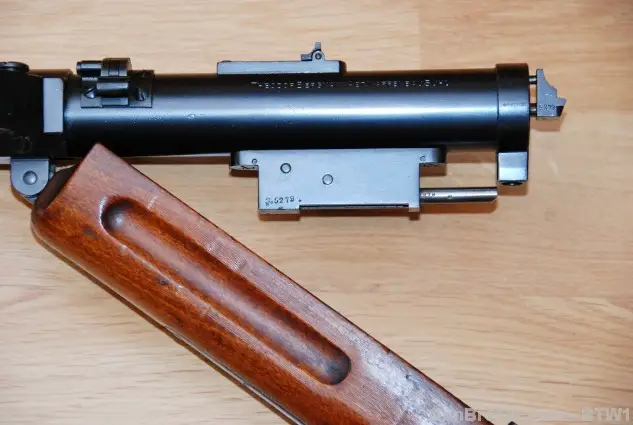
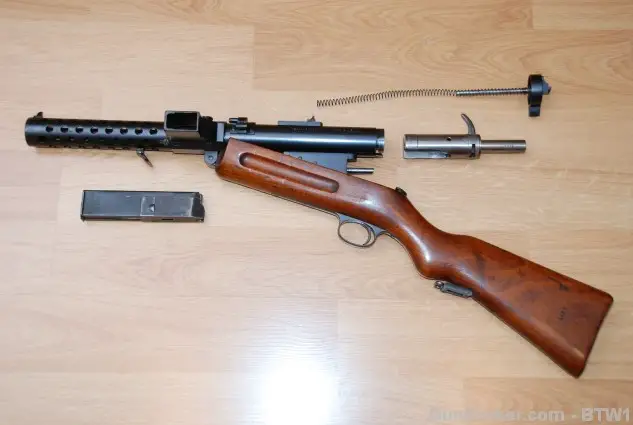
17 thoughts on “SMG History on the Block: German MP18-1”
How important was the decision to go with the Luger’s snail mag to the curse of double column/single feed magazines in the MP18’s successors?
I don’t believe it was a factor. A 2->1 mag can work perfectly well. After the war, Thompson had a patent on the double column, double feed mag, I believe. But I don’t think that’s why Schmeisser designed the 2->1. I think he wanted to keep the same bolt, and in fact the converted MP.18s did have the same bolt… only the mag and mag housing changed (and they did make the cut in the receiver for the safety notch). That was, AFAIK, the extent of the conversion.
The MP-35, which is a Bergmann-designed successor to the 18, uses a double-column, double feed magazine. They were used all through the war by all kinds of non-Heer types. The MP-35 lost to the MP-38/40 during the Heer SMG selection competition.
I’m still trying to find out what was the first true subgun, German MP18 or italian Beretta M1918, an one-half of Villar_perosa stocked into the carbine-style stock. Italians claim that the latter hit the front several weeks before MP18, but I never seen any proof to it.
I’ve seen a couple of the Beretta VPs in museums, and the narrative was usually that they were end-of-war or postwar weapons. They seem much less common than Villar-Perosas. Since the Italians were on the winning side in that war, you’d think they might have archives somewhere that record who the bright guy was that said, “you know, if you took half of this thing and dressed it up like a rifle, you might really have something.”
There’s not enough written in English about the Italian-Austrian fronts in the Great War, or the Eastern Fronts (where both German and Austro-Hungarian forces faced Russians). Perhaps the anniversary over the next few years will bring some of that information out.
The Beretta SMGs are all interesting. The only one I have a lot of hands-on with is the postwar M12 / M12S. And its Taurus clone. It’s a great gun, one of the best open-bolt subguns, but came too late.
wonder if this contraption can be considered a “true SMG’…
Heh. I’ve never seen this abortion before… the whole Villar-Perosa with a stock. it looks like a prop from Cinecitta (Italian Hollywood), but it probably was some real idea circa 1918.
Hey, it took a while for car makers to figure out steering wheels were better than tillers, and for airplane makers to accept ailerons were better than wing warping (new materials are giving wing warping a second look these days, though).
I find it perplexing that production smg’s took that long to appear..
Blowback smg’s being some of the simplest autoloading firearms out there, and a number of people experimented with pistol cartridge full auto weapons.
No one thought that a goodish amount of controllable close-range firepower would be desirable?
No one wanted to waste that much ammo in so little time, unless it became necessary by changes of infantry tactics during WW1.
Semi-auto pistol-caliber carbines were known well before WW1, but it seems that there was no need for full auto until trench warfare started.
The technology was there (although, automatic weapons were 20-30 years old, like say 3D printing or private space firms now) but the concept was what had to come together, in my opinion.
You are right about how militaries worry about “wasting ammo.” (The idea, in the context of the near-global waste of life and resources that was the Great War, is an outrage, isn’t it?) But that has always been the case and was behind the resistance to breechloaders, repeaters, machine guns, SMGs, assault rifles. To me there is something obscene about a general from the logistics side saying, “We can’t have the soldiers wasting this ammo by firing it at the enemy.”
Of course, much of the rapid-fire ammo misses, but most of the old slow fire ammo did, too. I have been rereading Bilby’s Small Arms at Gettysburg and it’s striking (1) how much the elements equipped with breechloaders (mostly Sharps) fired compared to their muzzle-loading comrades, and (2) how there doesn’t seem to be any visible difference in combat effect between the Sharps regiments, the rifle-musket regiments, and the still-smoothbore regiments mostly firing “buck and ball.” (That was one full-caliber ball and three smaller buck shot, another way to create more dispersion and more lead downrange).
I find that weird.
It’d imply that the soldiers with breech-loaders missed more often, as their rate of fire was what.. triple that of those with rifled muskets?
It’s a really bizarre finding, but it might be because getting in front of even the smoothbore-armed units (most of them from the Northeast of the USA, like New York and Pennsylvania) was extremely lethal.
Europeans might well laugh at the casualties of the US Civil War, but it was our bloodiest war, with 600,000 killed in action.
At the risk of resurrecting an old thread, I visited the National WW I museum today and they happened to have a MP 18 with a snail magazine. I noticed on this model that the magazine inserts at an angle as opposed to 90 degrees like the one in your post.
Yes, because the Trommelmagazin 08 was designed for the Lange 08 pistol, a long-barreled Luger, and the same “neck” of the mag that inserts in the pistol grip, inserts in the MP18. An MP18 (original model) can fire from 8-round Luger pistol magazines, not that that’s anything but a gimmick.
No problem on reanimating an undead thread (at 30 days, the comments are frozen to control spam). You can always get our attention with a photo like that! Where is the National WWI museum?
The National Museum is in Kansas City. They have a good representation of arms from both sides both land and air. They also have a number of artillery pieces along with a 4 inch naval cannon.
One thing that amazed me is that they have a Renault tank there and the front most track wheels have a wooden center. I think we forgot how close WW I was to the horse drawn age.
If I remember right, they must have have at least three Lewis guns there. The Winchester 1895 in 7.62 x 54R was pretty cool too.
Let me know if you want any pictures I’ll send them to you.
Ford built a crapton of those tanks under license, and very few of them survived.
The German Wehrmacht primarily traveled by rail and horse-drawn transport in WWII, also. Motorized units were a well-publicized minority.
Another angle.